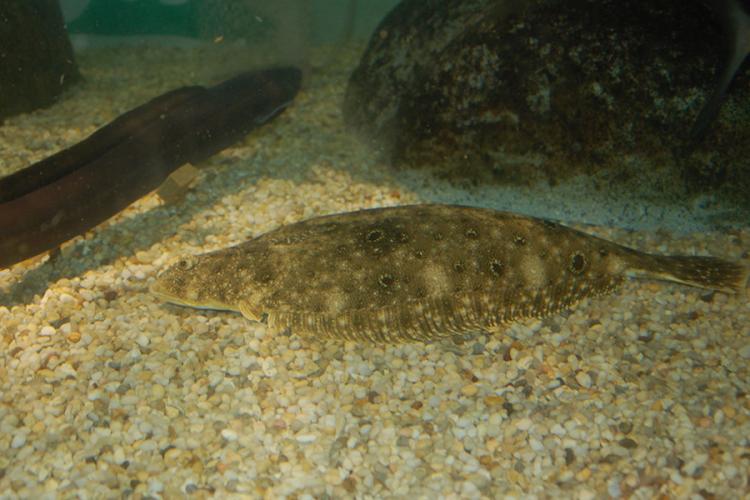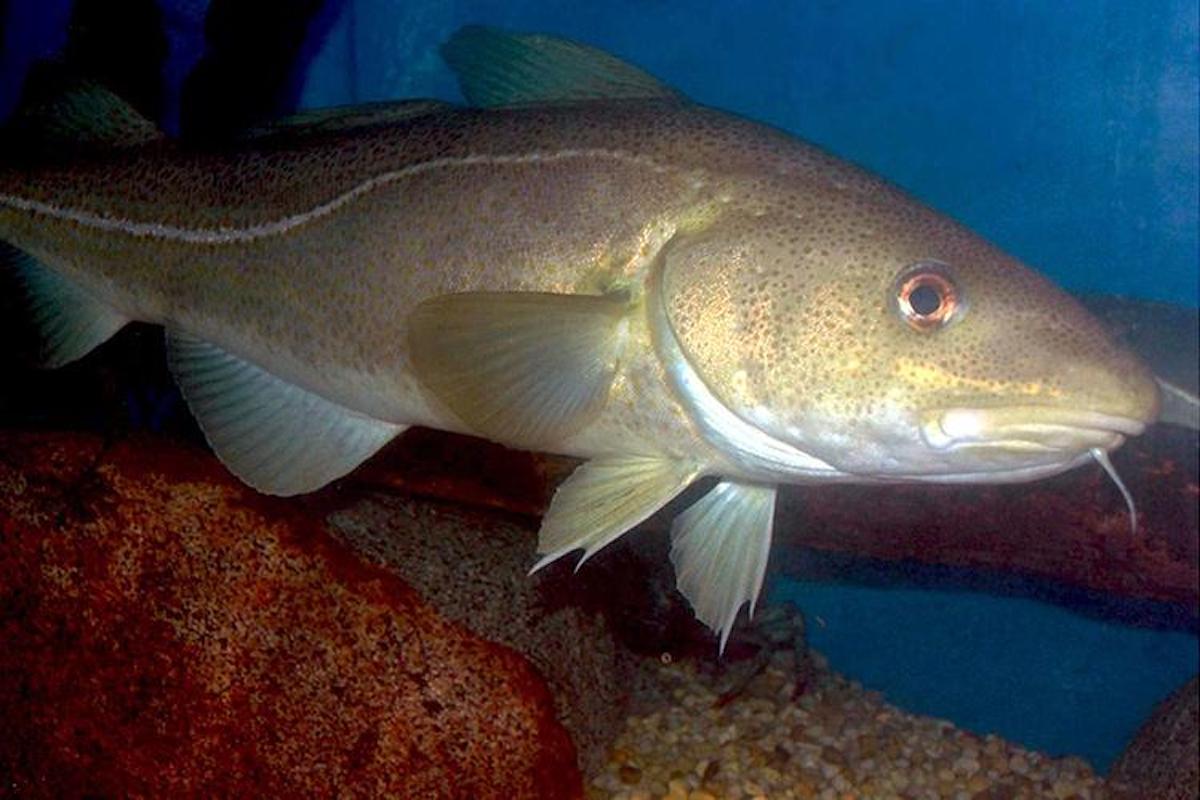Overfishing and environmental changes have wreaked havoc on Atlantic cod populations. Tim E White / Getty
Atlantic cod has been a fishy-fry mainstay in America, but with the catch last year sinking to a new low, commercial fishermen are now targeting different species.
The majority of commercially caught cod come through docks in Maine, New Hampshire, and Massachusetts. Last year, Maine fishermen caught fewer Atlantic cod than in any other year on record. In Maine alone, fishermen used to bring in 20 million pounds of cod in the early 1990s. The catch has dwindled to 50,000 pounds last year, according to records cited by Penn Live. That means the catch is only 0.25 percent of what was caught in the 90s. Nationwide, commercial fishermen brought in about 1.6 million Atlantic cod in 2020. The national numbers for 2021 have not yet been released.
Because of this decline, the U.S. has started importing fish from countries like Ireland and Russia. Since the Ukraine war Russian cod are banned. With cod populations being so low, fishermen tend to avoid them altogether.
“We can’t catch cod. The quota is so low that nobody could target cod,” said Terry Alexander, a fisherman based out of Harpswell, Maine. “That’s how we’re going to handle it.”
Targeting Flounder
What’s interesting is that the rest of Maine’s fishing industry seems to be doing just fine. It has even grown in recent years, according to Penn Live.
“What has happened is distribution of fishing effort hasn’t changed, but the distribution of the fish has changed dramatically, so they are much more distributed to the north,” said Coby Needle, Head of the Sea Fisheries Programme at MSS Marine Laboratory in Aberdeen, Scotland, to Sustainable Fisheries.
With Atlantic cod being less important for commercial fishing, fishermen are turning to other species of fish, including flounder. Flounder fishing in the U.S. operates from Maine to the North Carolina and South Carolina border, according to NOAA. They’re most common in the mid-Atlantic region. This might seem like a good solution for solving commercial fishing issues on the East Coast, but it’s not that easy.
In North Carolina, for example, commercial fishermen catch 70 percent of summer flounder, according to Davie Country Enterprise Record. Recreational fishermen and wildlife advocates aren’t thrilled about that figure. Earlier this year, wildlife groups sued the state for failing to protect coastal fisheries over the years, citing the amount of flounder commercially fished as a key indicator. The lawsuit contends that by letting high levels of commercial fishing occur, the state is driving down the population of the fish.

Commercial fishermen in some cases have turned to flounder. NOAA
The state pushed back, saying its plan to keep the 70 percent commercial and 30 percent recreational split and then transitioning to a 50 percent, 50 percent split makes sense. In addition to the split happening, the state’s plan would mean a 72 percent reduction in overall catch, giving the population time to come back up.
“Whether those fish are caught by a commercial fisherman or by a recreational fisherman doesn’t change the amount that comes out of the population,” North Carolina Division of Marine Fisheries spokesperson Patricia Smith said to WRAL.
Currently, summer flounder aren’t considered overfished by NOAA. However, other types of flounder, such as winter flounder have been overfished. Winter flounder has an overfished status in Georges Bank, Southern New England/Mid-Atlantic area, and the Gulf of Maine, according to NOAA.
Simply switching bottom-dwelling fish species can’t be the answer to overfishing issues for commercial fishing. Sustainable fishing practices, like those practiced in Iceland appear to be the best solution to keep fish populations at the proper levels. This offers the best solution for commercial fishermen and recreational anglers alike.
The Cod Decline
At the heart of the cod decline is high-pressure commercial fishing throughout the latter part of the 20th century, plus environmental changes, according to the NOAA.
Take the Celtic Sea off the coast of Ireland, the Gulf of Maine, and Georges Bank near Cape Cod, for example. These areas have seen dramatic dips in Atlantic Cod populations. They are where a lot of overfishing occurred.
However, not all regions are seeing the same declines. The Barents Sea near Iceland has Atlantic cod stock at its highest levels in 70 years, according to an article by Sustainable Fisheries funded by the University of Washington. In 2017, Iceland Magazine touted the country’s sustainable fishing practices as the reason for its success. Also, the North Sea in northern Europe has seen a dramatic drop in cod populations over the last decades, but now there are signs of numbers coming back up.
It’s not all just about overfishing, though. Environmental changes play a role, too. Oceanographic factors can greatly impact cod in northern parts of the Atlantic Ocean. “Norwegians and Icelanders both agree with first-order oceanographic factors playing a big role in changes in productivity they see in their stocks” said Jake Rice, Chief Scientist Emeritus at the Department of Fisheries and Oceans, Canada, in part two of a Sustainable Fisheries report. “Cod really don’t do well when the water gets down below 0°C.”

Near Iceland and Northern Europe, Atlantic cod populations are doing well. NOAA
“The concern is that it might be getting too warm, and conditions are more favorable for some other species than they are for cod,” said Rice.
Steve Murawski, Professor of Biological Oceanography at the University of South Florida, told Sustainable Fisheries that cold winters typically help cod stocks near the Gulf of Maine and Georges Bank. “Generally those stocks do well in cold winters and there hasn’t been a cold winter for a number of years…that has resulted in decline in recruitment success, etc.”
While Atlantic cod are generally well-managed, Murawski said that different programs—of which there are several—have different approaches. This has led to observed differences in stock status.
In the end, the story of Atlantic cod populations around the globe is a mixed bag. Places that have experienced years of overfishing are struggling, and locations that have not and instead focused on sustainable fishing practices, seem to be doing fine. Globally, Atlantic cod numbers are increasing, but once you break it down by area, it’s clear that many stocks have higher harvest rates than fishery management organizations would recommend—Maine is a perfect example of this.
The post Amid Declines in North American Atlantic Cod, Commercial Fishermen are Turning to Gamefish Species appeared first on Outdoor Life.
By: Wade Thiel
Title: Amid Declines in North American Atlantic Cod, Commercial Fishermen are Turning to Gamefish Species
Sourced From: www.outdoorlife.com/fishing/atlantic-cod-catch-declines-commercial-fishing/
Published Date: Mon, 16 May 2022 19:06:46 +0000
----------------------------------------------
Did you miss our previous article...
https://manstuffnews.com/weekend-warriors/how-in-the-hell-do-you-miss-a-turkey
 Backyard GrillingWeekend WarriorsAdvice from DadBeard GroomingTV Shows for Guys4x4 Off-Road CarsMens FashionSports NewsAncient Archeology World NewsPrivacy PolicyTerms And Conditions
Backyard GrillingWeekend WarriorsAdvice from DadBeard GroomingTV Shows for Guys4x4 Off-Road CarsMens FashionSports NewsAncient Archeology World NewsPrivacy PolicyTerms And Conditions
